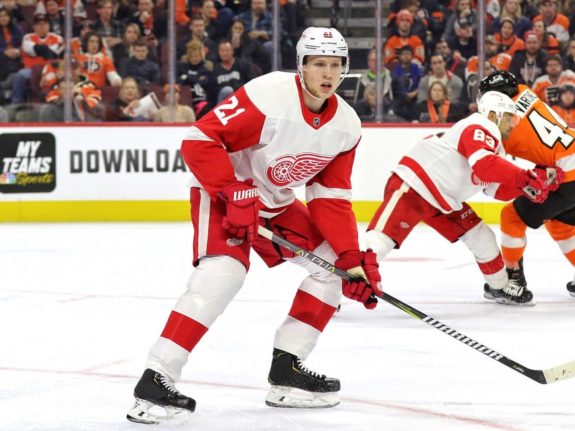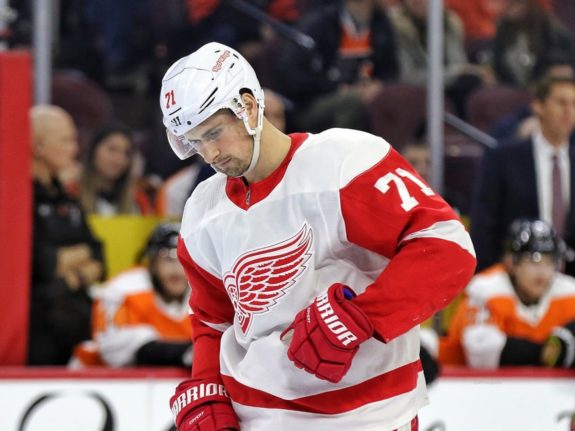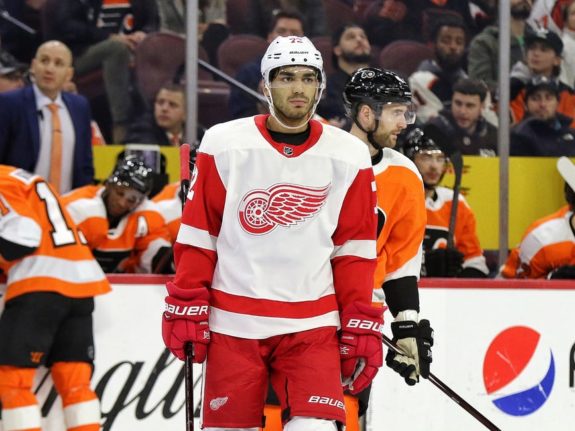![]()
Over the summer, the Detroit Red Wings stated that they would give preference to their younger players moving forward. Instead of deferring to the veterans, the “tie would go to the young player.”
As you would expect, this news was music to Red Wings fans’ ears but was met with some skepticism. For decades, the organization has relied on veterans to play heavy minutes and over-ripened their young players in the minors and in sheltered NHL roles. But with the team rebuilding, the next generation should and deserves to be playing more and gaining valuable experience.

So as we approach the midway point of the 2018-19 NHL season, let’s revisit Jeff Blashill’s comment on more ice time for Detroit’s young players. Are they indeed playing more? And if so, are the Red Wings better for it now and in the future?
Related – Red Wings Trades: When Will Holland Strike a Deal?
Red Wings Divvying Out Ice Time
For the purpose of this evaluation, let’s take a look at Detroit’s 24-and-under players (U24) and how much ice time they’ve received this season compared to the 2017-18 campaign. All situations are considered here, not just five-on-five.

First, let’s take a look at the 2017-18 data:
- Total seconds played: 1,462,039
- U24 seconds played: 382,155
- U24 ice time percentage: 26.14%
Next, the 2018-19 data through the first half of the season:
- Total seconds played: 735,017
- U24 seconds played: 306,193
- U24 ice time percentage: 41.66%
Overall, the Red Wings’ U24 players are on the ice more than last season. In fact, they’re on-pace to play 60 percent more than they did a season ago.
In particular, Dylan Larkin and Andreas Athanasiou’s average times on ice are up 9.49 percent and 7.62 percent, respectively. This is partially due to Henrik Zetterberg’s departure as Frans Nielsen’s time is up as well. Additionally, Tyler Bertuzzi is seeing more ice time as well – he has played 7.29 percent more than he did last season.
Related – Red Wings Prospect Rankings: Top Risers & Fallers
Are the Red Wings Better?
Now that we know Detroit’s younger players are on the ice more, let’s evaluate if it’s making a difference. Last season’s team struggled in all facets of the game, but goal-scoring was especially bad. Overall, the team averaged 2.59 goals-per-game, fourth-worst in the NHL. So far this season, they’ve slightly improved to 2.76 goals-per-game, 25th in the league, but still not good enough for the team to contend. How much does this increase have to do with the additional ice time for Detroit’s younger players?

Again, let’s take a look at the 2017-18 data first:
- Total goals: 212
- U24 goals: 76
- U24 goals percentage: 35.85%
- U24 goals per game: 0.93
And now the 2018-19 data through 41 games:
- Total goals: 113
- U24 goals: 66
- U24 goals percentage: 58.41%
- U24 goals per game: 1.61
The good news: Detroit’s U24 goals percentage has certainly increased. The bad news: the team is only on-pace to reach 226 goals by the end of the campaign – just 14 tallies better than last season.
Larkin and Bertuzzi have already surpassed their goal totals from the previous season and Athanasiou should join them soon. Anthony Mantha, who was counted on to be Detroit’s next 30 or 40-goal man, will need a jump-start to match his 24 goals from the 2017-18 campaign. He’ll need 15 markers in the second half to do so – it’s not impossible, just unlikely given Mantha’s streaky play.
Detroit’s team performance has also improved slightly. Their 2018-19 points percentage sits at .451, just above last season’s final percentage of .445.
Final Word
Blashill has stayed true to his word – the kids are indeed playing more. They’re also scoring more as well. The departure of Zetterberg in addition to injuries on defense have something to do with this, but Detroit’s core young players are producing in their expanded roles. In addition, Dennis Cholowski’s ascendance and power play duties are a sign that the times are changing, especially when he received man advantage time over Niklas Kronwall.
This increase in ice time and improved offensive play bode well for the rebuild. This trend should continue next season as well, with Michael Rasmussen fully acclimated to the NHL and Filip Zadina and possibly Joe Veleno joining him in Detroit.